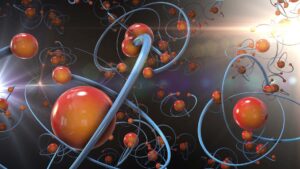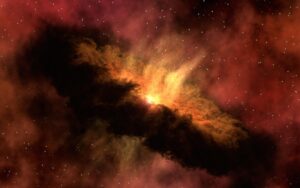Formation of Stars
The First Stars
In this section, we will learn how the first stars were formed out of the primordial hydrogen and helium gas that existed in the early universe. We will learn how as the universe expanded and cooled, small density fluctuations in the gas caused it to collapse under its own gravity. This collapse led to the formation of dense regions called “protostars.” As the protostars continued to collapse, their cores became hot enough for nuclear fusion to begin, at which point they officially became stars.
Section Preview: A 3D schematic of a galaxy
From something unbelievably tiny, unbelievably dense, and incredibly hot, suddenly, space, time, and all molecular matter burst in ways that no words can express. The Universe expanded at an unfathomable rate in a fraction of a second. Some recognised subatomic particles and fundamental forces emerged as a result of this expansion. The Universe then began to cool drastically, to around 1 billion degrees Celsius, allowing energy and ultimately matter (plasma of nuclei, electron and photons) to emerge.

As the universe expanded, plasma grew cooler and cooler. The universe cooled down further to 3000 K, making it possible for the nuclei in the plasma to gain electrons and become full-fledged neutral Hydrogen and Helium atoms.
Photons of light tangled in the plasma could now move freely and were released. The universe became transparent for the first time. This is known as cosmic microwave background that we can see even today.

The entire universe consisted of Hydrogen and helium gas clouds with no stars or planets.
After the release of CMB, nothing in the Universe radiated light until around 200 million years after the Big Bang when the first stars began to form.
The cosmic "dark age" is a term used to describe the period of time in the early universe when the first stars and galaxies had not yet formed, and the universe was largely dark and diffuse. This period is thought to have occurred between the end of the cosmic "dark ages" and the formation of the first stars, which occurred around 150 million years after the Big Bang.
During this time, the universe was primarily composed of hydrogen and helium, with small fluctuations in density. As the universe expanded and cooled, these density fluctuations led to the collapse of small regions, forming the first generation of stars, called population III stars.
It's important to note that during this time, the universe was still mostly dark, as the first stars were not able to produce significant amounts of light. It wasn't until the formation of the first galaxies, when the first massive stars began to form and eventually die in supernovae explosions that the universe began to light up and the cosmic "dark age" came to an end.
Due to gravity, hydrogen and helium clouds began to clump together. Tiny imperfections. Little knots, wrinkles, and flaws began attracting nearby particles of matter. The clumps grew, became more massive, and attracted more particles. Hence, it made them denser, and as a result, gravity became more intense. As the clouds compress more and more, they became hotter, until the center became so hot that nuclear fusion began. This released a tremendous amount of energy, which caused the earliest stars to light up. The gravity that was trying to squash the star together was pushed back by the fusion at the center which created a balance. Within a few hundred million years after the Big Bang, the first generation of stars, known as Population III stars, were formed. After CMB, these stars were the first source of visible light in the universe.
Stars formation happened almost everywhere in universe. Thus we have billions and billions of stars. Galaxies were formed out of these swirling clouds of stars and gas in space. Gravity sends these objects careening into one another as other clouds approached, knitting them into larger spinning packs. Material can be slung toward a galaxy's outskirts following collisions, forming large spiral arms filled with star colonies. Since, these were large scale structure it took a long time in an almost homogeneous gas clouds.


